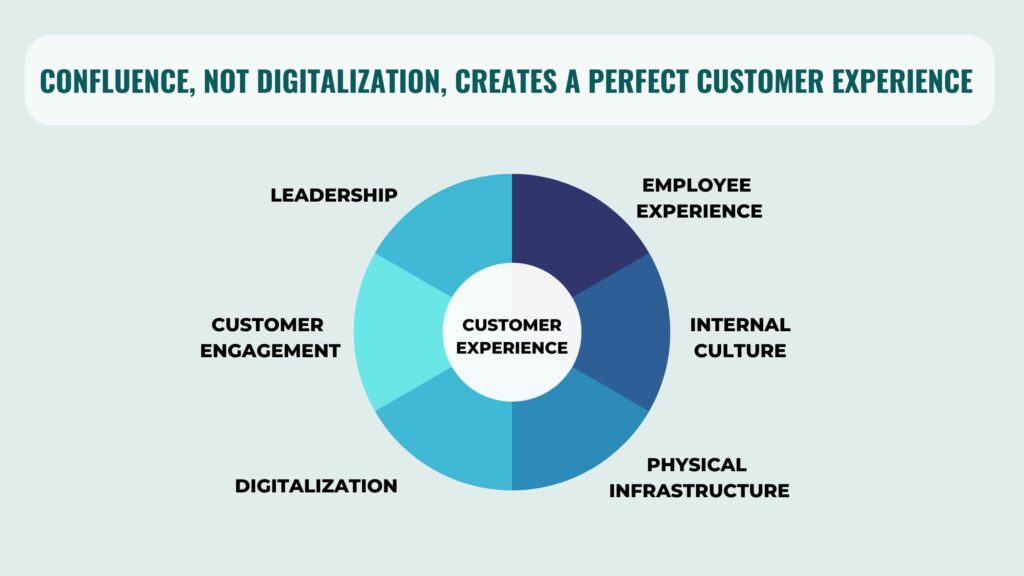We have become so obsessed with digitalization, digital enablement and digital differentiation, it’s almost as if we have forgotten that we are still human customers, having ultimately, a human experience in the world of business.
We are not unemotional robots or virtual beings who are fully wired to virtual experiences. The point of technology is to allow us to have fully human experiences. Technology is wonderful, but let us understand its place in the customer’s journey. It is a support to the overall customer experience that requires many moving parts to act in unison.
Now, I am a big fan of technology and its deep value-creating benefits, but I’m also a fan of other inputs that combine to create collective value to a business. For example, data analytics that reduce the level of anecdotal content in decision-making and corporate strategy that drives the achievement of goals.
Technology is wonderful, but let us understand its place in the customer’s journey.
Whilst we are busy migrating to digitally-enabled operations, we should not commit the sin of forgetting that ease of doing business and being able to navigate easily across a website, do not automatically equate to being the holy grail of an impeccable customer experience.
An important element of my interactions with leadership teams, is the discussion on confluence, or the smooth convergence of the moving parts of a business, an area in which leadership teams need to have clear-eyed focus. Equally imperative, is resisting the urge to be baited into thinking that there is a single, unique unicorn input that, on its own, can unlock business success.
It’s easy to spot a business that has momentum, because its wheels are turning, it’s showing continuous improvement in several domains, its culture is green and growing, employees love the customers and customer feedback is trending from complimentary to raving. There’s just a flow to the business. That’s what we call confluence and no, it’s not found in every business.
Whilst we are busy migrating to digitally-enabled operations, we should not commit the sin of forgetting that ease of doing business and being able to navigate easily across a website, do not automatically equate to being the holy grail of an impeccable customer experience.
Confluence generates momentum for a business. It’s akin to a highly skilled team of trapeze artistes, who are airborne and executing their routines flawlessly. Achieving this confluence requires impeccable timing, high-level expertise and unwavering concentration. If even one of these markers is off, things can go horribly wrong and with tragic results.
Getting a business to function in a state of confluence is a high achievement and one that requires skills that are similar to those of the trapeze artistes. Equally challenging, is the journey to this state. One of the first steps involves moving from a divergent, to a convergent style of functioning.
Often, when a prospective client reaches out to me with a request for a service improvement intervention, I can predict, pretty accurately, that the business has a divergent style of functioning. This style occurs typically, when a business is not aligned in values, strategy and mechanics. Just picture the trapeze artistes swinging away, each with his or her own cadence and the picture of divergence becomes crystal clear.
Getting a business to function in a state of confluence is a high achievement
The leadership teams that are open to converging all of the connective tissues of the customer experience, always do a better job at championing their businesses to service delivery success. These teams dedicate time and effort to green lighting the support machinery that will stitch the “native” experiences into a single, bespoke experience.
Native experiences comprise the existing footprints in the areas of culture, employee experience, digital experience, leadership experience, physical infrastructure, tele-communication access and customer engagement. Simply speaking, if all of these footprints are not converged into a smoothly connected experience tapestry, the service delivery will be incongruous.
My experience has been that many businesses do notice that they are failing in one or all of these native experiences, but choose to place their centre of effort in areas of their choosing, which may or may not be in the interest of advancing customer-centricity as a priority.
These teams dedicate time and effort to green lighting the support machinery that will stitch the “native” experiences into a single, bespoke experience.
For example, many businesses place their priority on meeting revenue targets. Not a bad thing, but the down side to this mentality is that the operating architecture gets built around sales, as opposed to “sales and service.” Had the priority been sales and service, the focus would have been placed on leveraging customer relationships as a valuable force to not only drive sales, but to build customer loyalty and guarantee repeat business.

